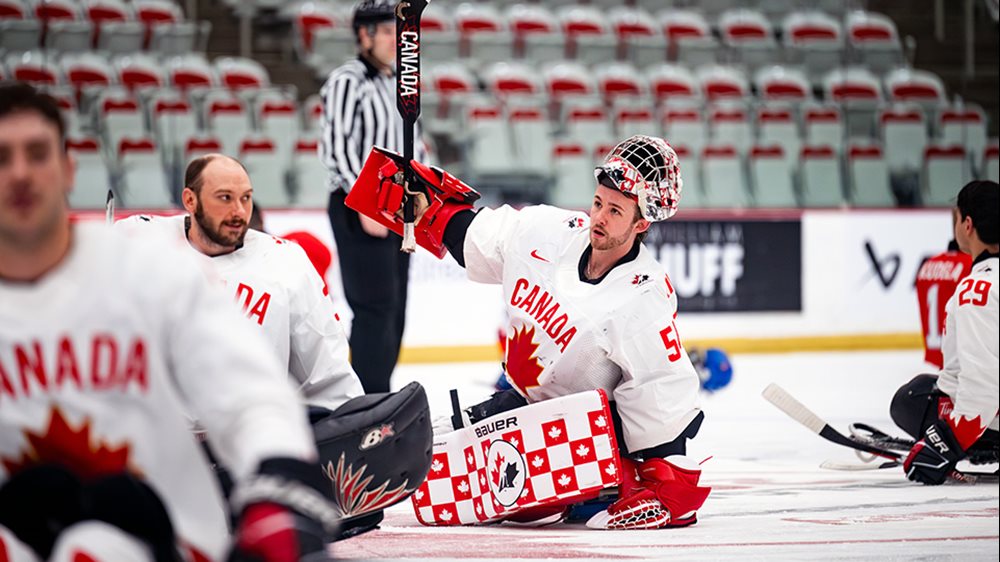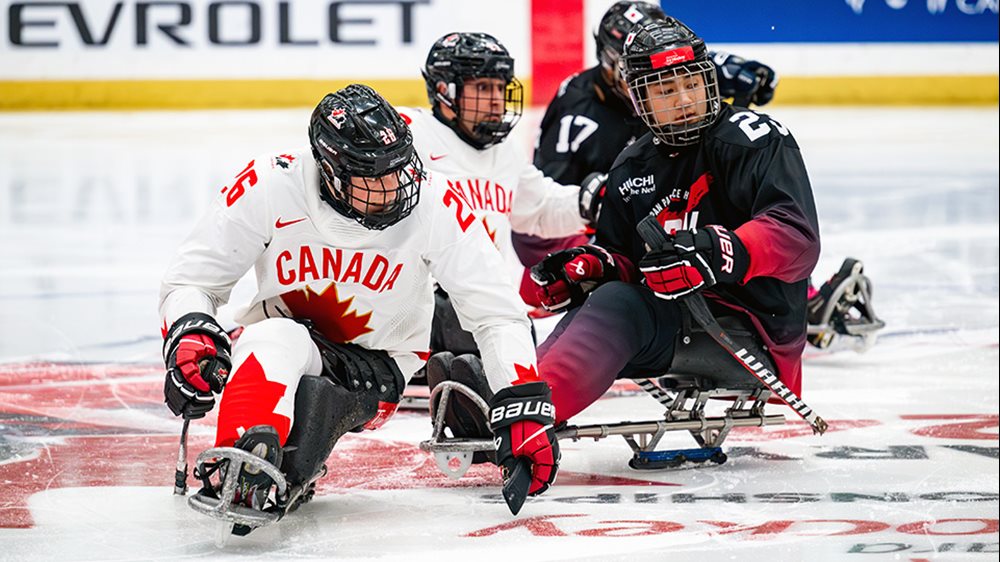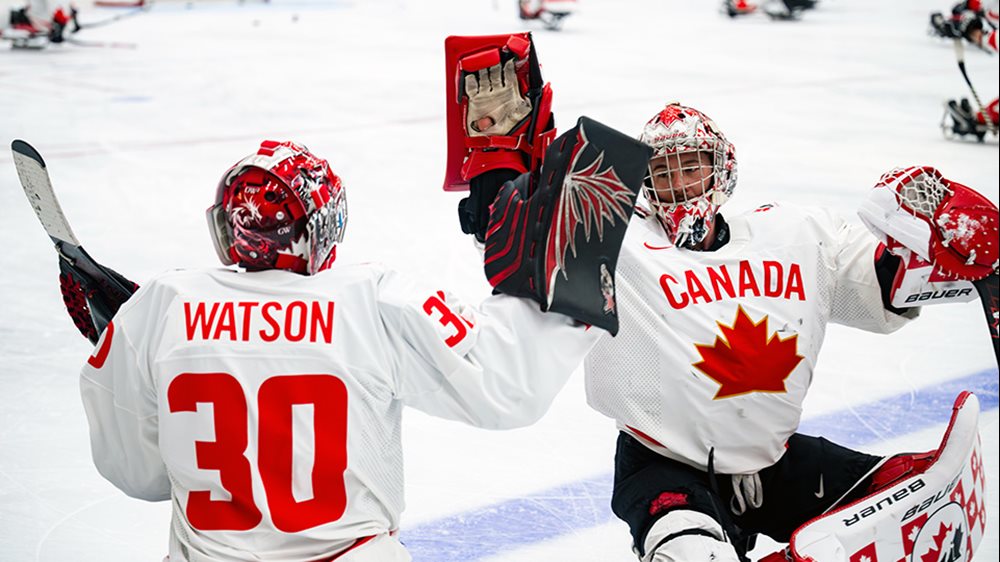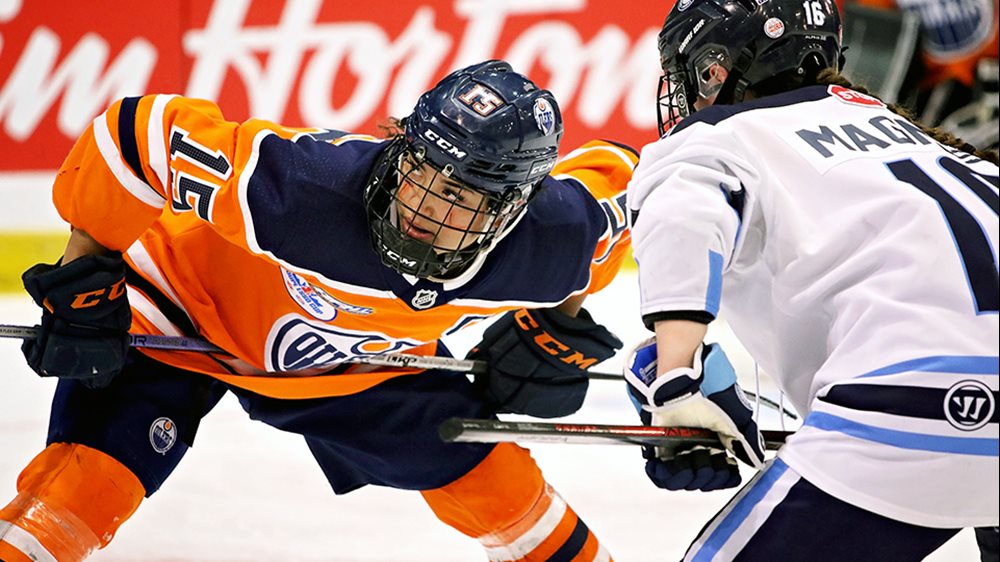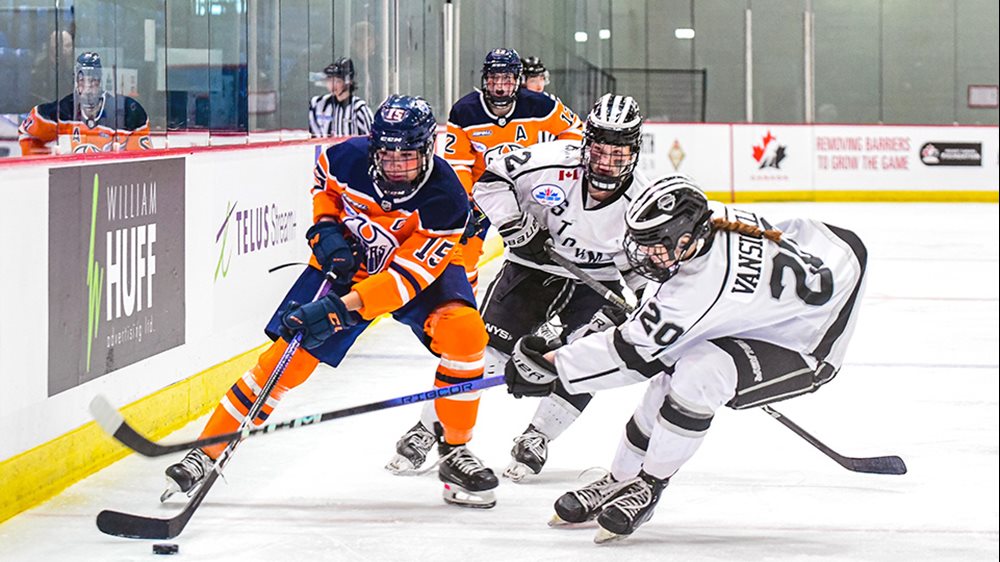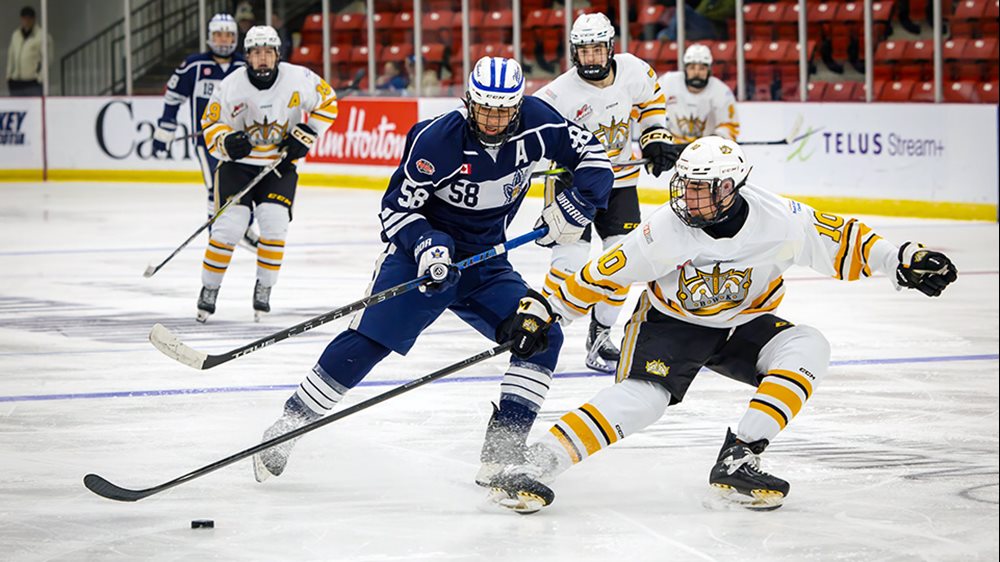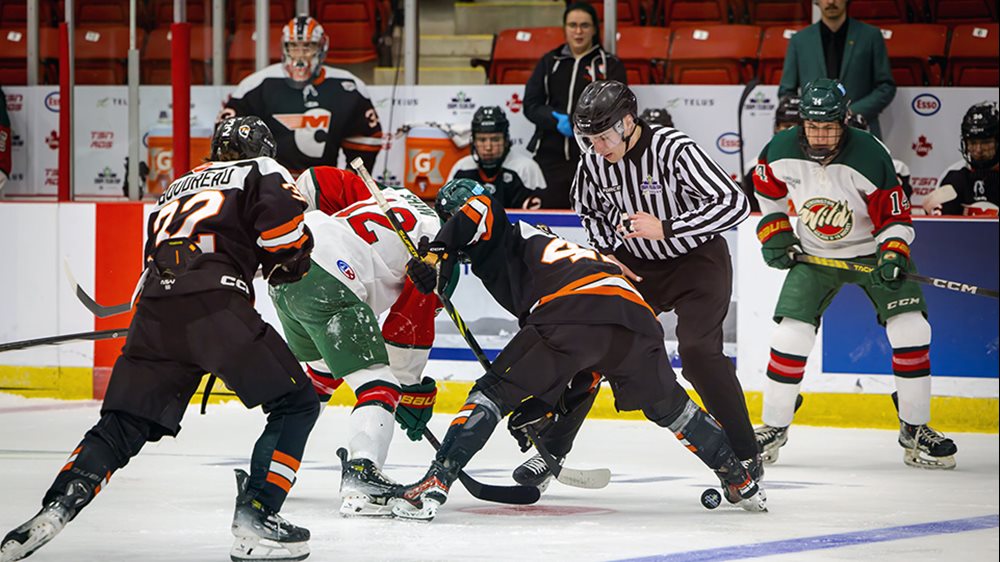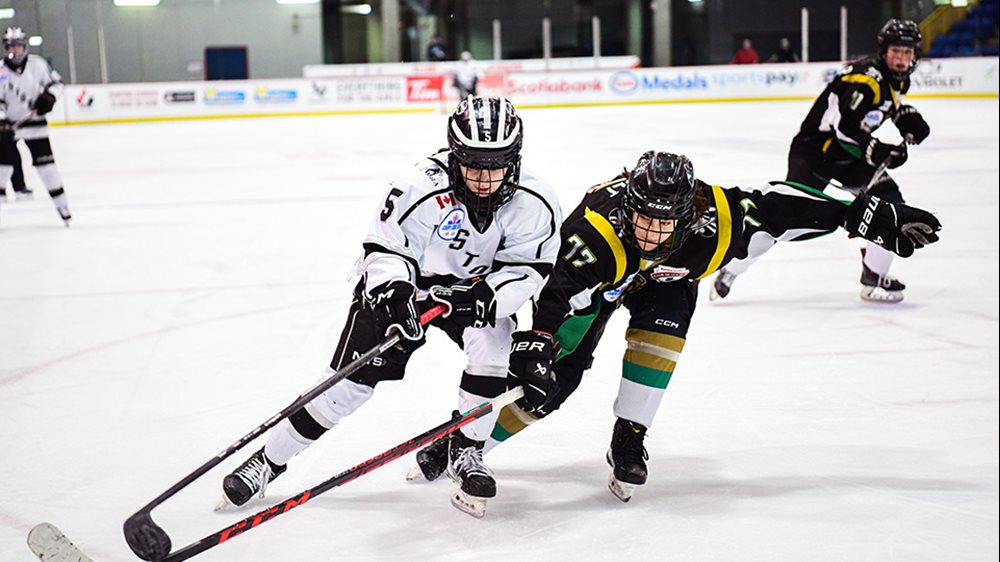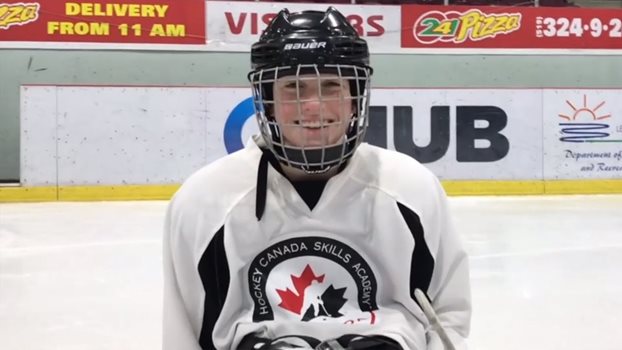

Finding a way to play
A Grade 9 student with the HCSA at Cardinal Carter Catholic Secondary School, Brody Daigneau has never let his disability define who he is
“Challenges are what makes life interesting. Overcoming them is what makes them meaningful” - Joshua J. Marine
Meet Brody Daigneau, a para hockey player who proves hockey is more than just a game, and adversity builds character.
Brody is a Grade 9 student with cerebral palsy who participates in the Hockey Canada Skills Academy at Cardinal Carter Secondary School in Leamington, Ont. The 14-year-old is no rookie when it comes to para hockey; he has been playing for eight years, currently with the Windsor Ice Bullets.
Brody is eager to continue learning and developing his hockey sense and he could not think of a better way to do exactly than by joining the HCSA.
“I saw it as a way to try and improve,” he says. “The goal is to make it far in this sport. I get on the ice three times a week, plus once a week with [the Ice Bullets].
“It’s interesting. It’s hockey. It’s a sport instead of doing a subject. You get up in the morning, go to the rink, get some cardio on the ice, work on some skills instead of being in a classroom. I’m actually hoping this semester slows down a little bit because I don’t want it to end.”
There are few better ambassadors for the HCSA program than Brody; he is a unique athlete who is faced with a challenge. His mild case of cerebral palsy affects his legs and the left side of his body. He explains it as “just a part of developing muscle memory.”
He has a remarkable mindset when it comes to not only dealing with his disability, but excelling with it.
“At the end of the day, I just have to accept it,” Brody says. “I’m not going to be able to change anything, so I just have to make the best out of it.”
Brody does not let cerebral palsy define him, as he has found a way to continue reaching personal goals through hockey. Not only does Brody spend his time training on the ice, he also volunteers to help coach the Tecumseh Minor Bantam Rangers.
There are many are inspired by Brody, but who does he look to to find inspiration? He is quick to reference Paralympic gold medallist Ray Grassi, national women’s para hockey team member Ashley Goure and Team Canada goaltender Corbin Watson, who is a Cardinal Carter alumnus.
Brody has had the opportunity to skate with all three, taking the opportunity to learn from those who have succeeded while experiencing similar challenges.
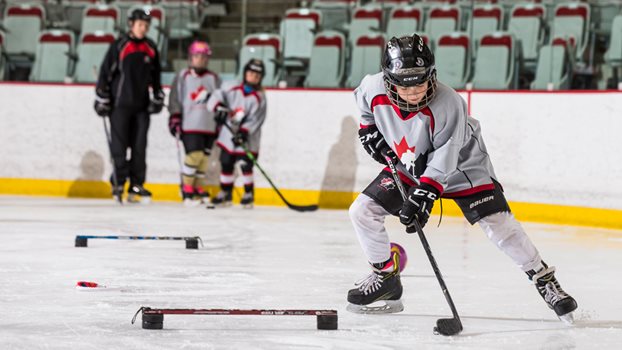
Skills to start a new semester
It’s the start of the school year for Hockey Canada Skills Academies, and finding different skills to evaluate players is key for planning lessons through the semester
The new school year has arrived, and students in the Hockey Canada Skill Academy (HCSA) program are excited to be back in the classroom and on the ice. After a summer away, the beginning of the semester is the perfect time to understand the skill level of students so lead instructors can customize their lesson plans to match the need of participants.
“At the start of the year, it’s all about evaluating a variety of skills to get a sense of where your players are at, from skills they are good at [to] skills they are challenged with,” says Corey McNabb, director of NextGen development at Hockey Canada. “That helps to build out your plan moving forward from there as far as what you want to teach and how you want to teach it.”
What types of skills should be included in the evaluation? Basic skating techniques and puck control techniques are good to include because those skills are used in a variety of drills and during games. Going over these techniques in small-area settings is also beneficial.
Instructors can evaluate some skills based on the player’s position. For example, defenders can begin with skating skills, then add in the ability to transition and pivot before finally adding in using a puck and passing it between teammates.
“I think where we focused was not necessarily skills, but game transferable skills [were] top of mind [when developing evaluation plans for athletes],” says Dean Seymour, manager of NextGen/player development for Hockey Canada.
There are also some off-ice evaluations that instructors can do at the beginning of the semester. For example, the instructors could lead students through a 40-metre sprint, a 5-10-5 agility test, a standing long jump or a medicine ball throw. Each of these evaluations can be used as benchmarks as classes progress throughout the school year.
HCSA participants come from a variety of hockey backgrounds, with some students who have played for years and others who are new to the sport. The benefit of working on basic skills is that the drills are applicable to every participant.
“The older you get [or] the higher the level, you’ll just be able to execute them better,” McNabb says. “But there’s not [many evaluation skills] that I would say you can’t do with minor hockey age players.”
When it comes to lesson planning, McNabb recommends focusing on the key teaching and evaluation points, so instructors are looking at specific items within a drill rather than students completing the drill without a clear purpose. Planning out the semester in advance can also help keep instructors on track for achieving their success goals.
“Create a schedule and stick to that schedule, and try not to skip too far in advance,” Seymour says.
If students at an HCSA are involved in hockey outside of the program, it’s good practice for instructors to have open communication with local hockey association coaches.
“Talk to the coach and say, ‘Hey, what do you suggest? What do you think these [players] need to work on?’ They can try and collaborate that way,” McNabb explains.
For HCSAs with students that are new to the sport, repetition of drills over the semester can be a great way to work on basic hockey skills.
“Almost all drills involve turning left, turning right. They’re skating, there’s passing, they’re shooting. They are all designed to keep kids active,” McNabb says. “I think kids will get better just by doing [drills].”
Looking for inspiration for skills and drills to include in an HCSA practice plan? The Hockey Canada Network app has over 1,500 drills and more than 100 lesson plans to give coaches and players the tools to succeed. Drill Hub is another resource available to instructors, with access hundreds of drills and videos for free.
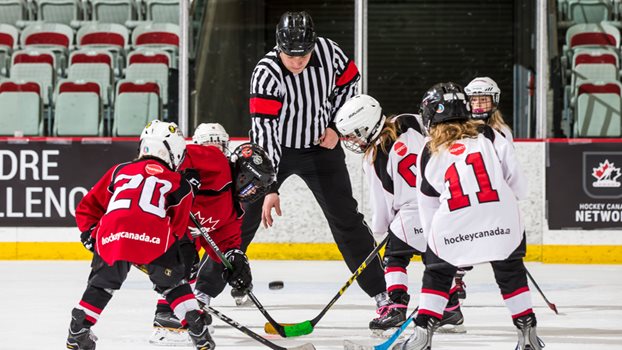
Support during the school year
From sharing resources and drills to additional coaching certifications, support is available as Hockey Canada Skills Academies prepare lesson plans
School is back in session, and that means another Hockey Canada Skills Academy (HCSA) season is underway. As students return to the classroom and to the ice this school year, here are a few resources instructors can incorporate into their HCSA curriculums.
Skills and Drills
The Hockey Canada Network app gives coaches and players the tools to succeed with drills, skills, videos, practice plans and articles on their tablet or phone. There are over 1,500 drills and more than 100 lesson plans available on the app, with more added throughout the season.
Drill Hub is another resource available to instructors to find skills and drills for students. It is a free resource for coaches and instructors to access hundreds of drills and videos. There are also pre-made practice plans available to download, along with templates for game rosters, player stats, scouting reports and more.
Looking for more drill inspiration? Hockey Canada will frequently post skill videos on its social channels that can be incorporated into practice plans. Search the hashtag #HCSkillsCoach and #HCGoalieCoach on Twitter, Facebook and Instagram to find more drill videos to utilize on the ice.
Coaching Certification
All HCSA lead instructors need to be certified in the Respect in Sport for Activity Leaders program. They also need to have the Coach 2 – Coach Level from the National Coach Certification Program (NCCP) or, at a minimum, be trained in two of these instructional stream clinics: skating, developing defencemen, skills or small-area games.
However, there are opportunities to expand coaching certification to a higher level, including taking more instructional stream clinics or NCCP coaching programs such as Development 1 or High Performance 1. Hockey Canada’s coaching web page explains the difference between the levels and provides example coaching pathways. Instructors should connect with their Hockey Canada Member for more information on higher-level coaching certification.
HCSA Members
For more resources, be sure to log into the HCSA account on HockeyCanada.ca. Once logged in, instructors will have access to the HCSA curriculum, practice plans for on- and off-ice activities, support tips and links to previous HCSA seminars.
With over 150 HCSAs across the country, it is encouraged to reach out to lead instructors at other schools to share insights and tips. Local hockey associations in the area can be another great resource as lesson plans are finalized. For further support throughout the school year, contact Drew McLaughlin, manager of Member engagement and school programs.
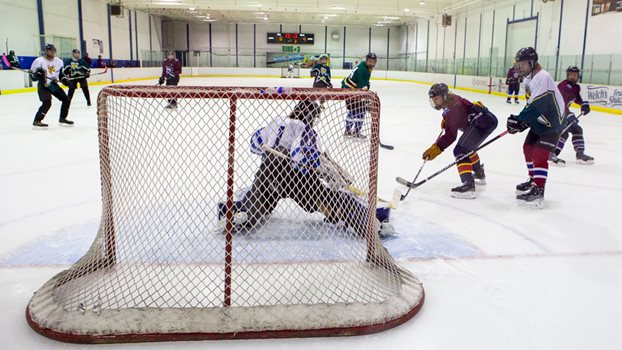
Embracing the ‘old normal’
With a return of normalcy across Canada, Hockey Canada Skills Academies were excited to get back to regular programming for students across the country
Throughout the 2021-22 school year, a return to normalcy grew across Canada – and with it a clear majority of Hockey Canada Skills Academy (HCSA) school programs had the greenlight to return to pre-2020 practices.
Jaydee-Lynn McDougall, who just completed her first year as an educator at Technical Vocational (Tec-Voc) High School in Winnipeg, Man., is thrilled her year as dance instructor, physical education teacher and HCSA lead was a journey with very few restrictions.
“Where I picked the program up, we were at a point in Manitoba where you no longer had to wear masks on the ice, so it worked out very well,” the 26-year-old says. “The last two years, they had not been on the ice even though they could sign up for the skills academy, so they have been missing that integral part. That’s why they signed up for the class, right? To be on the ice to improve their hockey skills.”
The school year in many ways represented a refreshing return to the ‘old normal’ that existed before COVID-19 entered public consciousness.
Greg Masterson, the supervisor of learning services with the Calgary Catholic School District (CCSD), concurs that the return to normalcy has been great.
“It has been wonderful for our students and our coaches to be back on the ice with no more restrictions,” he says. “You can tell there is a lot of excitement on the ice during the classes.”
Resumption of classic HCSA programming – two on-ice sessions, dryland training and classroom work per week for most academies – has once again spawned the benefits long associated with these programs since its institution during the 2000-01 school year: heightened academic performance.
“The Hockey Canada Skills Academies promote student wellness, and when students are feeling well, they are ready to learn,” says Masterson. “I noticed when I was a vice principal at how organized these students were away from rink and they demonstrated an appreciation of how privileged they are to have this opportunity to participate in the skills academy.”
McDougall said it was evident that the 20 Grade 10-12 HCSA students she mentored transferred their discipline and focus from the ice and gym into the classroom.
“I think the program really helped students become re-engaged in school and perhaps re-engaged in [life] in general,” McDougall says. “I had some students join the academy later in the year who were not doing well academically and after they joined in November they improved in their classwork, passed all their courses and are moving on to the next grade.”
The first-year teacher says she was heartened to see so many of her HCSA students actively participate in Tutor Friday hours at Tec-Voc. She’s observed the students approach this opportunity to dive into their academics with a similar rigor to their efforts to improve their edgework, puck-handling and shooting.
Inclusivity and accessibility are other celebrated hallmarks of the HSCA learning model. McDougall, who played Prep hockey at St. Mary’s Academy during her high school years, experienced these rewarding dimensions of the program during her rookie instructor year.
“It was really interesting coming into this program. I did not know what to expect in my first year,” she says. “I had students playing in a league outside of school and I also had a Grade 11 student who had never been on skates because of COVID-19. It was incredible to see the skill development there. The gap got smaller and smaller throughout the year because of the amount of times we were able to go on the ice and practice those skills.
“I think the students when they are together all year really get to know each other and accept each other. They were all helping one another develop their skills in the stages they needed. We had more split drills at the beginning of the year where we would do skill work on one side of the ice and challenges on the other side. By the end we had our practices all together.”
With another year in the books, there’s lots to look forward to in 2022-23. Both Masterson and McDougall expressed a keenness to further enhance accessibility and inclusivity with increased sledge hockey sessions for students. Until then, there’s lots to celebrate about the successes of the 2021-22 school year.
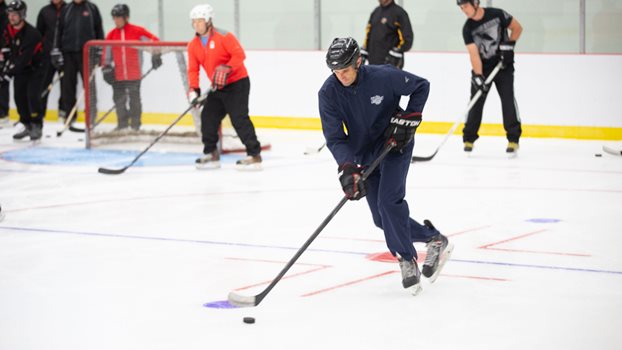
Inspiring instructors with innovation
The Hockey Canada Skills Academy summer seminar is making a return to in-person this year, with three days of programming that promises to be educational and inspirational
The 19th Hockey Canada Skills Academy (HCSA) summer seminar is a return to traditional roots.
After staging virtual summits in 2020 and 2021 because of the COVID-19 pandemic, over 70 hockey education delegates from all over the Great White North will convene at Markin MacPhail Centre in Calgary from July 7-9. HCSA program leaders will hear presentations from experts and engage in interactive exercises to attain insights on how to take their on-ice and classroom instruction to the next level.
Drew McLaughlin, Hockey Canada’s manager of membership engagement for school programs, says Hockey Canada is heartened and grateful that so many educators enthusiastically enrolled for this experience during their summer holidays.
“So many of them are teachers or have some role in the realm of academia day-to-day,” he says. “Understanding that this seminar is outside of the typical school year, their commitment to excellence and wanting to understand how to grow their program’s capacity to be more inclusive and beneficial is appreciated.”
Three expert facilitators will deliver the National Coaching Certification Program (NCCP) instructional stream components that will constitute the core programming of the seminar.
Darren Rommerdahl, a player development coach with the Calgary Flames, will guide shooting and scoring drills and impart on-ice and off-ice growth strategies that attendees could apply to their elementary or secondary school pupils.
Vanessa Hettinger, one of just two master skating instructors certified by Hockey Canada, is commissioned to guide the seminar’s on-ice skating presentation. A master instructor with Quantum Speed skating development company, Hettinger will also share student athlete development tips for players at and away from the rink.
Brett Dudar, a Hockey Canada trained skills coach and a High Performance 1 trained coach with Hockey Manitoba, has been tapped to demonstrate small-area skills and offer counsel about effective player and practice management. Dudar currently serves as the director of player development for the Evolution Hockey skills development organization in Winnipeg.
Gina Kingsbury, the director of hockey operations for Canada’s National Women’s Team, will be the keynote speaker. Ross McCain, the director of athletic performance and manager of the Duckett Performance Centre at Edge School in Calgary, will guide a presentation entitled A 360 Degree View on Student-Athlete Development.
Keen to foster strong Member participation in the seminar, McLaughlin said he is pleased four senior provincial officials are joining the 2022 event in a leadership capacity. The hockey leaders are BC Hockey’s manager of athlete development, Dave Cunning; Hockey Northwestern Ontario’s interim executive director and technical director, Jim Fetter; Hockey Manitoba’s director of hockey development, Bernie Reichardt; and Hockey New Brunswick’s technical director, Matt Vautour.
McLaughlin says this event, featuring a welcome return of the face-to-face networking missing the previous two years, is poised to be enriching.
“There is a strong appetite among our attendees and across our 155 school programs across the country to have access to this kind of professional development, education and an opportunity to gather with like-minded individuals to work on best practices and understand at a peer level of how different programs operate.”
For McLaughlin, this will be his first HCSA summer seminar. He looks forward to witnessing the thought-provoking ideas and innovations that will emerge as hockey experts and academic professionals pick each other’s brains. It is safe to suggest that each delegate in the room are wired with a desire to ensure the HCSA nationwide footprint remains vibrant for years to come.
The HCSA program will celebrate its 23rd anniversary during the 2022-23 school year. McLaughlin says he expects that the academy will be a course offering in approximately 160 schools. On average, 5,000 students participate in HCSA classes each year. A hallmark of every school program is its accessibility. Any student, regardless of hockey experience, is welcome to enroll in the unique educational experience.
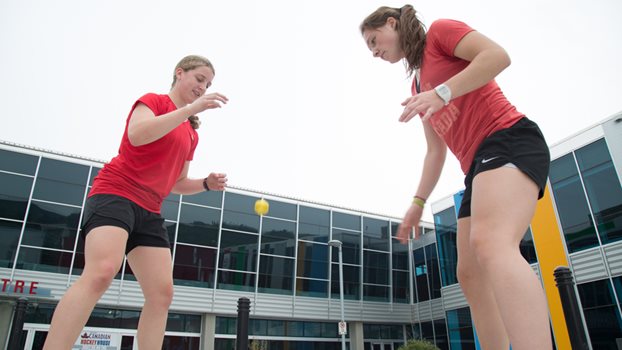
Staying active over the summer
From hand-eye coordination to improving your mobility, check out a few fun ways for Hockey Canada Skills Academy students to work on their skills over the summer
Warm weather means school is out for summer. As time away from studies and the rink begins for Hockey Canada Skills Academy students across the country, the anticipation for the next hockey season has already begun.
But before the next school year begins, some students may be thinking about what they can do over the summer to improve their game. While individual skills can be worked on, there is also an opportunity to work on transferable skills by playing additional sports.
“Baseball [is] great for your hand-eye coordination,” says Katie Greenway, hockey development coordinator for Hockey Canada. “Throw a frisbee, go swimming, ride a bike, do all these different things that are going to make you a more well-rounded athlete, because the best hockey players are the best athletes.”
Although not every sport has a stick or a puck, the skills needed to play hockey can be found in almost any activity. Running and soccer can help with foot speed and mobility on the ice. Tennis and basketball work on stopping and starting.
“The simplicity of hand-eye coordination with golf and badminton and the racquet sports — [these are] all very transferable athletic movements that are required in forward, defence and goaltending,” says Dean Seymour, manager of NextGen/player development for Hockey Canada. “I don’t really think it matters what sport you play or activity you’re doing, just get out and do it.”
Playing in additional team sports can also further develop hockey IQ over the summer.
“A lot of kids, I think especially during the pandemic, were so focused on individual skill that they don’t know how to play now within a team system,” Greenway says. “I think multi-sport, especially team sports, help with that IQ piece of game situation and how to read and react to certain plays, which transfer back over into hockey: finding an open lane, leading someone with a pass, working with other people.”
Something else that can benefit a player’s game is taking a brief step back from hockey to give their body a well-deserved break after working hard all season long.
“When I played, I would take a month off in the summer and it would change everything,” Greenway says. “You missed the rink, you’re excited to come back… I think that’s a huge piece.”
“[You] see the new energy in the player,” Seymour adds. “They may be rusty for the first week, but it’s like riding a bike, it comes back.”
Taking a break in the summertime can also help to prevent burnout and limit overuse injuries from repetitive movements.
“We see a big problem right now with a lot of kids that no matter what sport they play, if that’s the only sport they do, that overuse injuries are starting to onset earlier,” says Corey McNabb, director of NextGen development at Hockey Canada. “By promoting other activities, you’re going to not only balance the mental side of things, but you’re going to balance the physical side of things.”
After taking some time off, those looking to better their hockey play could try isolating specific skills over the summer. For example, a player could work on stick-handling in the garage, or a goaltender could work on catching with a glove. Students can also check out the Hockey Canada Network for more drills and resources.
However, a brief break from the rink to enjoy the sun outside can be exactly what a player needs to refresh and refocus before preparing for tryouts in the fall.
“It’s important to step away from the game a little bit and just be a kid, relax and enjoy the summer,” Greenway says.

Investing in hockey at school
Thanks to a Hockey Canada Foundation grant, Skills Academy programs can further eliminate barriers to play and increase interest in hockey
At Frontier Mosakahiken School in Moose Lake, Man., Jennelle Manko has lots of ideas for how she can grow her Hockey Canada Skills Academy program.
One way is by providing more activities options for students, and thanks to a grant from the Hockey Canada Foundation, her school now has access to new floorball equipment.
“I was really excited to have more options and more choices for the kids,” says Manko, who teaches Grade 3 and the Skills Academy program for Grade 9 to Grade 12. “We have weightlifting as an option, and then we have [floorball] now as an option, and we also had the rink and going outside to do outdoor hockey.”
Skills Academy programs were selected by the Hockey Canada Foundation to receive the grant, with the goal of eliminating barriers to play and maximizing off-ice skill development.
“We know that hockey is not always accessible to everyone,” says Hockey Canada Foundation philanthropy manager Alexandra Wise. “By providing this grant that can be used in schools where we know the kids are, they’ll have the chance to get experience playing hockey in a safe way and in an accessible way.”
For Manko, her school is in a small community home to the Mosakahiken Cree Nation. Since receiving the grant, she has noticed there has been an increased excitement about hockey in her school community.
“I think I’m going to have a lot more interest [in the Skills Academy program] and a lot more students wanting to be at school,” she says.
Timothy Biggins works in student services at Chief Napew Memorial School, located on Big Island Lake Cree Nation in Saskatchewan. When he found out his school was selected for the Hockey Canada Foundation grant, he was “ecstatic.”
“It provided a really good opportunity for the students for dryland training, especially,” he says. “We are able to utilize our multipurpose court that’s outside of the building on a regular basis.”
Currently, the Skills Academy program is only open to U9 players at Chief Napew Memorial School. However, Biggins hopes this grant will be a stepping-stone to gathering more interest and participants in the program.
“On a daily basis I have other kids in different grades asking me to be involved. So, I think it is a launching point,” he says. “With this grant and that support that was given and the accessibility to that equipment, we are able to share it with other groups, not just the U9s, and it is developing more of a keen interest in the sport.”
Biggins’ goal of fostering a sense of community through hockey is not limited to the walls of his school. He hopes that the entire community will embrace the sport and that the community will have a team of its own one day. One of the first steps in that goal is operating and growing the Hockey Canada Skills Academy.
After seeing his three sons grow up playing hockey, he wants to help get as many kids as he can get involved to also feel supported by the hockey community once the entry barriers are eliminated.
“I’ve just noticed that whenever we have athletes that come from the community and are involved in our local hockey community, that those students walk in the school with a little more sense of confidence, and I love it. I love seeing it,” he says. “I want it to go throughout all the grades so that when they are finished their academics in the [kindergarten to Grade 12] system that they feel confidence and they can move forward.”
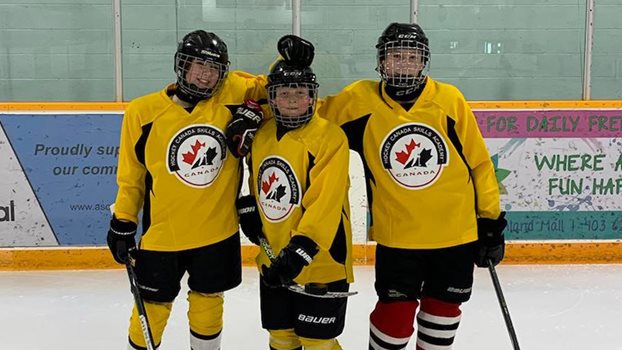
Cheering from Pincher Creek to Beijing
Wearing the Maple Leaf has created a special bond for Hockey Canada Skills Academy participants to Canada’s Olympians and Paralympians competing at Beijing 2022
The 23 students enrolled in the Hockey Canada Skills Academy (HCSA) at Matthew Halton High School are reminded of how they belong to a coast-to-coast-to-coast hockey community every time they don their practice jerseys.
Wearing the iconic Maple Leaf invites these teenagers from the small Southern Alberta town of Pincher Creek to symbolically link arms with Canada’s Olympic and Paralympic hockey teams.
“They recognize that the crest on the jersey in small-town Alberta is the same thing the big names wear,” says Bryan Burns, the HCSA instructor and vice-principal at Matthew Halton. “It really brings forth that spirit of unity and connection. It’s huge for the kids.”
Canada’s quest for Olympic hockey supremacy in Beijing was front of mind for Burns’ students throughout the global sports festival. Burns said his students’ excitement was palpable from preliminary action all the way towards the glorious finish of Marie-Philip Poulin propelling the women to gold with a three-point performance against the United States. That excitement is sure to carry over to the Paralympics, where Team Canada will begin another quest for gold in para hockey starting on March 5.
Matthew Halton’s students hoped one of the games in the medal round would line up with their HCSA class so they could cheer Team Canada in their jerseys. Burns says one student quipped “that being able to watch would be way better than doing math.”
The 15-hour time difference between Pincher Creek and Beijing nullified that possibility. But Burns says there is another way to commemorate Canada’s overseas hockey achievements in upcoming HCSA classes.
“We have an activity made where we are going to watch some of the game footage. We will get the students to point out the examples of good teamwork in the video and how players overcame adversity. Just looking at the women’s team wearing masks while playing. Little things can get in the way of your goal, but you have to focus on it.”
In the days before the Olympics began on Feb. 4, Burns penned a letter to Hockey Canada to express his hope for his students to enjoy the quadrennial tradition.
“One thing that it great about the [Olympics and Paralympics] is that every Canadian hockey fan can highlight a favourite moment from a game they watched at some point in their life. For some the moment is a goal while others it is being with family and friends huddled around the TV with pizza and snacks. For the students at Matthew Halton, I hope that they get the chance to see some amazing hockey and enjoy what hockey is all about…being with great friends and creating memories of a lifetime!”
Burns also expressed appreciation for the aspirational power of the Winter Games. The lone girl enrolled in the HCSA program can watch her television to witness Sarah Nurse set new tournament scoring records with 18 points and 13 assists. The student can be empowered knowing Nurse’s road to becoming an Olympic champion began in minor hockey too.
Canada’s men’s and women’s national teams recognize and appreciate the power of a child—and older fans, too—making the special effort to stay up into the early morning hours to watch their hockey heroes. These athletes routinely thank fans during interviews, share social media posts and make time for autographs and pictures to show gratitude for the deeply passionate Canadian hockey community.
After coming away with silver in an overtime loss to the United States in 2018, Canada’s Paralympic Hockey Team has its eyes on finishing atop the Paralympics podium for the first time since 2006. The students at Matthew Halton may be thousands of kilometers away, but the support and pride they have for Team Canada can be felt across the world.
“We will absolutely wish the best for our athletes,” he says.
Is your HCSA celebrating the Paralympics? Show off your Canadian Paralympic spirit as our team goes for gold by tagging @HockeyCanada on social media.
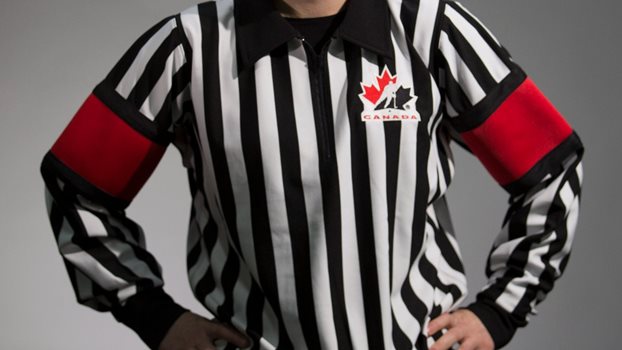
A new road to officiating
A successful officiating pilot program at St. Joan of Arc High School in Barrie, Ont., may spark a future trend for Hockey Canada Skills Academies across the country
Brent Crawford sought a learning module to constructively fill a sizable chunk of the off-ice, classroom content for St. Joan of Arc High School’s Hockey Canada Skills Academy (HCSA) in Barrie, Ont.
His decision to present an online officiating clinic to his students ultimately transcended to be effective time-filling content. Crawford, the instructor of this Catholic high school’s HCSA since its September 2014 debut, has motivated multiple Grade 9-10 students to pursue officiating certification. He also potentially generated a fresh access route into Hockey Canada’s Officiating Pathway.
In a sense, the unorthodox hybrid learning schedule—a split between in-person and remote instruction—induced by the COVID-19 pandemic paved the way for positive developments. Instead of several moderate scheduling blocks sprinkled throughout the school week, administrators had to get creative and schedule nearly the entire school day to elective studies.
Crawford and his team knew fitness activities, health instruction and lectures celebrating the rich history of Canada’s game could account for some of the instruction away from the rink, but infusing a new ingredient into this mix was necessary.
“An officiating clinic jumped to our minds right away, and we went online to look up some online clinics because most of the in-person options were closed down due to COVID,” Crawford says. “We saw some [resources], but it was unclear if we could get the kids to do it and if any of them would be interested in going on down the path to becoming referees.”
His instinct to contact Jeff Stewart, the director of program and events for the Ontario Hockey Federation (OHF), paid off handsomely. Stewart connected Crawford with former NHL official Greg Kimmerly, who is currently fulfilling a two-year term as the OHF’s referee-in-chief.
“Right off the bat, Greg was excited, and he saw the value in getting a lot of young kids excited about officiating,” Crawford says about the initial meeting last October. “Before long, he and his team put together six PowerPoint presentations starting with referee initiation and working up to learning about four-man systems and all the penalty symbols.”
According to Crawford, the St. Joan of Arc HCSA crew responded well to the interactive features of Kimmerly’s presentations. The students were shown multimedia of various on-ice incidents and challenged to determine how they would approach these scenarios if they wore the zebra-stripe uniform.
Immersing in the intricacies of a fast-paced and demanding job also led to increased player-to-referee appreciation.
While not offering an exact count, Crawford says many of his students seek to complete Level 1 of the Hockey Canada Officiating Program (HCOP) to attain certification and ideally volunteer within the Barrie Minor Hockey Association in short order.
This development delights Dan Hanoomansingh, Hockey Canada’s manager of officiating.
“Officiating is an opportunity for hockey players to see the game from a different perspective, in a way that is flexible with their busy schedules, and earn some money,” he says. “When their competitive pathway as a player comes to an end, they have a natural transition to stay involved in hockey.”
The HCSA students are poised to enter the HCOP with confidence because their school gives them a leg up.
Ultimately, the pilot version of the St. Joan of Arc officiating clinic went so well that Crawford says there is a strong possibility of being renewed for the 2022-23 academic year.
“Even as we shift back to a normal schedule next year, I am definitely going to recommend we incorporate it again, and for all sorts of other programs across the country, too.”
Hanoomansingh is thinking on the same wavelength as Crawford.
"The Officiating Program is always looking for individuals with skating skills and hockey sense to join our ranks. Partnerships with our Hockey Canada Skills Academies is a fantastic opportunity to expose these individuals to officiating and give them an opportunity to be involved in the game in a different way."

Returning to the rink
After a 2020-21 season full of uncertainty, the return to a sense of normalcy for local hockey associations and Hockey Canada Skills Academies is cause for excitement
There’s excitement buzzing around rinks from coast to coast to coast. Skates are freshly sharpened, sticks are newly taped and Canadians are celebrating the return of hockey.
After a season full of uncertainty last year, the return to a sense of normalcy is a welcomed sight for local hockey associations and Hockey Canada Skills Academies (HCSA).
“There’s tournament planning going on and exhibition games going on. Everybody’s just excited to get going,” says Trevor Hanley, a U18 AA coach from Martensville, Sask.
All the programs in Dave Tressor’s school board in Kenora, Ont., were not able to run last year due to the COVID-19 pandemic. With the return of our game, the program at Beaver Brae Secondary School is set to be reinstated in February.
“We’re so excited to have an opportunity to get the academy back and get the students going again,” says Tressor, who is the vice-principal at Beaver Brae.
In Athabasca, Alta., 2020 was supposed to be the inaugural year of its HCSA at Edwin Parr Composite School. The anticipation has grown over the extended start date, but the wait has paid off for the Grade 8 and Grade 9 students.
“Anytime somebody talks to me about hockey academy, I get the stupidest grin on my face because I’m just so excited,” says assistant principal Brenna Liddell. “I’m like a kid on Christmas Day, it’s so exciting. Our kids are having a great time and our parents are really adjusting well.
“I spent two weeks before November break meeting with each of our kids that are in it. We talk about academics, we talk about attendance and then I say, ‘Hey, tell me how hockey academy is going,’ and every single kid smiles and says it is the best thing in the world.”
For Porter Creek Secondary School in Whitehorse, Y.T., it was able to run its HCSA last year, but it focused mainly on skill development due to the restrictions from COVID-19 safety guidelines.
“I think [the students] are excited about the fact that they can do more gameplay [this season],” says Amy Vermeulen, the lead instructor at Porter Creek.
The program at Porter Creek runs in the second semester of the school year, but the buzz about the return of a more normal hockey program is already affecting the students.
“I see a few of them all the time in the halls,” Vermeulen says. “They talk about how excited they are to just get the semester over so they can start the hockey program.”
Local hockey associations across the country are also looking forward to getting back to a sense of normalcy. In Prince Edward Island, teams are back on the ice, but the main difference this season is the amount of time teams are allowed at the rink before practices or games.
Blaine Fitzpatrick, a Charlottetown Minor Hockey coach for the U15 AAA female team, knows the socialization before hitting the ice is beneficial for his team.
“They just wanted to get back to the way it was, be able to hang out, have some fun and chit-chat beforehand. We’re getting closer to that, we’re allowed in 30 minutes before now on a consistent basis, so that gives them that fun time at the rink,” Fitzpatrick says. “The excitement level is much higher because of the opportunity to potentially have a normal season as it was before COVID.”
One thing players in Yellowknife, N.W.T., are looking forward to is the return of tournaments.
“We generally get to play against the other smaller communities,” says U7 assistant coach Patricia Parker. “They come here, we go there and then we get to see a little bit of the town, they get to go to the swimming pools, and that’s the one thing they’re really missing right now.”
Hanley says everyone is back on the ice in his association, with U7 through to U11 teams practicing while U13, U15 and U18 teams have already started league play or are gearing up to begin. Last year, Saskatchewan teams were able to practice throughout the season, but they were limited to eight players on the ice at one time.
“It stretched a lot of guys to be creative and keep it innovative and exciting for the kids, so they’re excited to get back to full teams, working with everybody at once and certainly having the opportunity to coach in games,” Hanley says.
Creativity and adaption have certainly flourished over the past 18 months. With locker room restrictions in Yellowknife, Parker had to adapt to helping her young players get ready.
“They came fully dressed, but we had to tie their skates, untie them and bring them back to the parents,” she says. “We actually got to bond with them more because you got to talk to each kid as you were tying their skates and get to hear what they did on the weekend, or they would tell you what they had for dinner.”
Inspired by the NFL, Fitzpatrick created a playbook with all the team’s basic coverage systems last season so each player on his team can review it whenever they please.
“We don’t have as much time at the rink to go over lines with the group, so [each player] has that in a booklet at home,” he says. “They can spend their own time getting familiarized with that aspect of the game.”
Despite the uncertainties and challenges the pandemic brought, communities from coast to coast to coast are looking forward to using hockey to promote an active lifestyle.
“Mental health was a real concern, and I think this concern was not only throughout the province, but throughout the country,” Tressor says. “The hockey academy program provides a great avenue for students to exercise and get back and socialize again.”
Now that Our Game is Back, everyone is ready to get back to playing the game they love.
“It’s nice to see that they’re going to hopefully have a normal rest of their minor hockey careers and be able to enjoy their time at the rink with their friends,” Fitzpatrick says. “They’re going to work hard and develop, and you never know, maybe give themselves some opportunities down the road. I’m really excited for the kids.”

Creating a positive culture
The emphasis of inclusivity at Hockey Canada Skills Academies has helped to foster a positive culture for those who participate in our game from coast to coast to coast
At the beginning of each school year, Ryan Miller delivers the same speech to his Hockey Canada Skills Academy (HCSA) students at Osoyoos Elementary School in Osoyoos, B.C.
“We talk about what a privilege it is to be a part of an organization like Hockey Canada,” says Miller, who has helmed the hockey academy at Osoyoos Elementary for over a decade. “It is one of the top sports organizations in the world, and if you doubt that, go visit the [Hockey Canada] Hall of Champions in Calgary.
“I tell them that Hockey Canada creates a culture that values hard work and respect for every individual at the table.”
This past June, the national sports organization made a momentous step to forge a safer, more respectful and inclusive on-ice culture in Canada. Approval was granted for the adoption of Section 11 – Maltreatment in the Hockey Canada rulebook, which brings all forms of mistreatment under one umbrella. There are clear penalties for inappropriate behaviour from players and team officials.
There is also a new reporting system that will make it easier to report discriminatory incidents. Hockey Canada, like everyone, wants rinks free of discrimination based on race, ethnic origin, skin colour, religion, age, sexual orientation, gender identity and disability.
“Hockey Canada has made a firm commitment to making the game safe and inclusive for all who wish to participate, and the introduction of Section 11 provides our 13 Members, local hockey associations and officials across the country with clearly-defined criteria for enforcing rules related to many different forms of inappropriate conduct,” Hockey Canada CEO Tom Renney said when the rule was announced. “We believe this is a great step towards ensuring we limit the number of incidents that occur on and off the ice and will allow players of all ages to enjoy our game free from abuse, discrimination, racism and all forms of maltreatment.”
These changes delight Miller.
“We are seeing a change in what is accepted and not accepted. It’s nice you are seeing changes at the elite level and it is starting to trickle down to the grassroots. I still think we have a long way to go, but I do believe with so many things happening around the world with Truth and Reconciliation, and Black Lives Matter, that more awareness is out there and people are seeking to understand.”
Inclusiveness has always been a bedrock principle of HCSA institutions from coast to coast to coast, and it is an important aspect for fostering a positive culture for participants.
David Ruggiero, the long-time HCSA coordinator for Central Okanagan Public Schools until 2019, has seen students from a variety of backgrounds come through the program.
“From the start, we had a lot of international students participate. This year we have one [Mexican player] who played roller hockey before, so he is learning ice hockey this year and is doing a good job.
“The way we start the year is a talk in the classroom about the privilege of being in this program and the privilege of travelling away from the school to participate in the program. While you are at the arena, you are still a member of School District 23, so the rules and principles that apply in the classroom apply here.”
One protocol installed in the Central Okanagan Public Schools system to deal with any form of bullying in the HCSA program is having the vice-principal of each school involved in the disciplinary process, if necessary. This ensures the school’s senior administration leaders are invested in ensuring the culture within school walls, and the culture at the arena remain in alignment.
Ultimately, inspiring students to invest in the notion of being standard-bearers of respect is key to inspiring HCSA programs devoid of maltreatment, says Miller.
“We talk about how we create a culture of safety and respect. Every day we don’t really get to choose what happens to us, but we get to choose our attitude and effort, and that dictates what we do with what happens to us.
“We want to create a thinking culture. They are the bosses of themselves, so they get to decide if they want to follow me or not. I talk about how I hope to have proven myself to be trustworthy, organized and hardworking, and that I am someone who they want to follow. We want to be thinking when we watch drills, and we want to think about how to support our teammates positively.”
For more information: |
- <
- >















